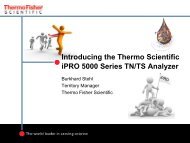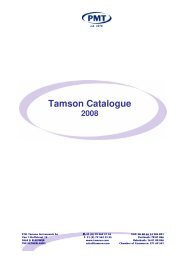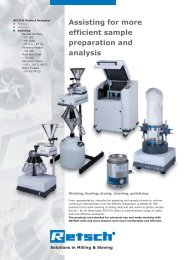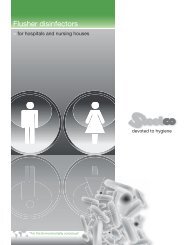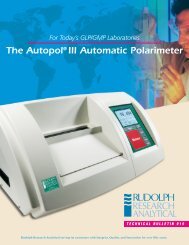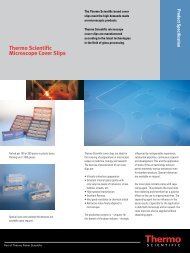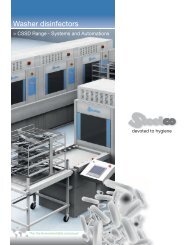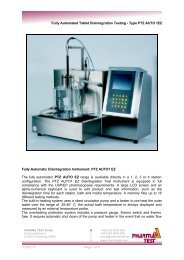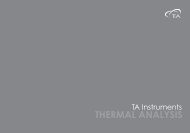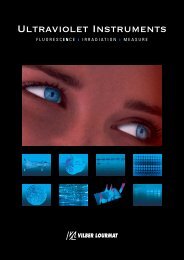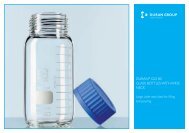QuAAtro english 2008_02.indd
QuAAtro english 2008_02.indd
QuAAtro english 2008_02.indd
Create successful ePaper yourself
Turn your PDF publications into a flip-book with our unique Google optimized e-Paper software.
AA<br />
QU TRO<br />
THE LATEST IN A HISTORY OF INNOVATION<br />
HISTORY OF THE AUTOANALYZER<br />
THE BIRTH AND GROWTH OF CFA<br />
In the early 1950s Leonard Skeggs, a researcher in a clinical<br />
laboratory, had the innovative idea of adding air bubbles<br />
to a flowing reaction stream so that one sample after<br />
another could be introduced without interacting. From this<br />
idea the Technicon AutoAnalyzer was born in 1957.<br />
Within a decade it had become a dominant instrument<br />
type in automated analysis. In the late 1960s the AutoAnalyzer<br />
II was introduced, having air injection phased, smaller<br />
manifold components and a linear output. New techniques<br />
such as solvent extraction, automated digestion and continuous<br />
distillation were developed.<br />
By 1975 almost 8000 papers on CFA – more accurately<br />
termed SFA or segmented-flow analysis to distinguish it<br />
from flow-injection analysis FIA – had been published.<br />
MICROPROCESSORS AND HYDRAULICS<br />
After the complex definition of dispersion in segmentedflow<br />
streams had been derived by Technicon's Lloyd<br />
Snyder, micro-flow systems with higher segmentation<br />
frequency and sampling rates over 100/h appeared.<br />
At the same time, computers were built into the instruments,<br />
so that in a decade data calculation moved almost<br />
completely from ruler and calculator to dedicated computer<br />
or PC.<br />
TECHNICON, BRAN+LUEBBE AND SEAL<br />
By 1980 there was a clear division in system design<br />
between instruments intended for clinical and industrial<br />
use. In 1987 Technicon divided into separate industrial and<br />
clinical divisions, and the industrial division was bought by<br />
Bran+Luebbe. At the end of 2006 SEAL Analytical bought<br />
the continuous-flow business, so ensuring continuation of<br />
the AutoAnalyzer lineage.<br />
The CFA analyzers are designed and manufactured in<br />
SEAL's Technical Centre in Hamburg, Germany. Here the<br />
tradition of research and innovation is combined with German<br />
design skill and high quality manufacture to produce<br />
analyzers with exceptionally high performance and long<br />
working life.<br />
QUAATRO is the latest result of this fusion, and is the<br />
world's most highly automated CFA analyzer.<br />
DESIGN<br />
QUAATRO's design objectives were to reduce the detection<br />
limit, and to reduce the need for operator training by<br />
making the system monitor its own operation.<br />
Our engineers and chemists in Germany and Japan<br />
worked together with experts at the Netherlands Institute<br />
for Oceanographic Research, Royal NIOZ. Skilled users<br />
from the University of Hamburg helped to define and<br />
automate the tasks which are routinely performed by an<br />
expert user.<br />
The result is a closed, thermostatted system which checks<br />
its own performance and has a very low detection limit.<br />
QUAATRO AT A GLANCE<br />
QUAATRO COMBINES IMPROVED PER-<br />
FORMANCE WITH A HIGHER LEVEL OF<br />
AUTOMATION<br />
QUAATRO is an integrated system where only the sampler,<br />
PC and reagent bottles are external. Up to four<br />
methods can run at the same time on one console, and<br />
there is a special 5-channel version for nutrients in seawater.<br />
Two consoles can be combined to give an 8-channel<br />
system. The modular architecture allows easy expansion<br />
and adaptation.<br />
QUAATRO uses microflow hydraulics, which enables<br />
higher sampling rates with lower reagent consumption.<br />
It is ideal for laboratories with large numbers of relatively<br />
clean samples. QUAATRO's high speed and multi-channel<br />
design mean that 1000 results per day can be generated<br />
with ease on a typical system.<br />
SYSTEM FEATURES:<br />
High speed – sampling rate typically 1.5 - 2 times<br />
higher than a macroflow system.<br />
Low reagent consumption – per sample, typically<br />
one half to one quarter of a macroflow system.<br />
High reproducibility – about 0.4% RSD for most<br />
methods.<br />
Low detection limit – 0.1 µg/L P in seawater.




